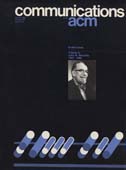March 1980 - Vol. 23 No. 3

Features
General considerations on the design of an interactive system for data analysis
Among the most important criteria in the design and implementation of an interactive system for data analysis are: data structure, control language, user interface, sytem versatility, extensibility, and portability. The design of an interactive system, viewed as a set of constrained decisions based on these criteria, will be discussed. The concepts and considerations discussed in this article about the design of interactive systems are general in nature and are neither problem-specific nor discipline-specific. Specific examples from statistical packages and their designs are cited for illustration purposes only.
Text is not the only data that needs editing; for example, file deletion utilities edit directories. If all “editors” used the same command language, they would be easier to learn, remember, and code. This paper describes a generalized editor that edits text, directories, binary core images, and certain operating system data with a single user interface.
A linear algorithm for copying binary trees using bounded workspace
An algorithm to copy a binary tree in linear time using bounded workspace is presented. The algorithm does not modify the original tree at any time. The copy is constructed in such a way that it can be traversed in a read-only fashion even before the copying process is complete, provided one can distinguish between the original and the copy. The traversal can be carried out in parallel with the copying.
Region representation: quadtrees from boundary codes
An algorithm is presented for constructing a quadtree for a region given its boundary in the form of a chain code. Analysis of the algorithm reveals that its execution time is proportional to the product of the perimeter and the log of the diameter of the region.
Region representation: boundary codes from quadtrees
There has been recent interest in the use of quadtrees to represent regions in an image. It thus becomes desirable to develop efficient methods of conversion between quadtrees and other types of region representations. This paper presents an algorithm for converting from quadtrees to a simple class of boundary codes. The algorithm is shown to have an execution time proportional to the perimeter of the region.



